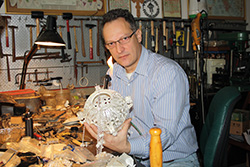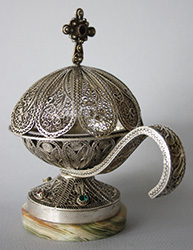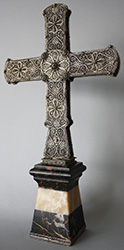Ars sacra
GORAN RISTOVIĆ POKIMICA, MASTER OF FILIGREE
Revival of the Forgotten Art
He had a well-paid managerial position, but he left it all and responded to the call. He united the craft and sacral, practical and aesthetical, on the highest level. He elevated the world of metal, supported with the significance and symbolism of precious stone, to the level of sacramental. He purified it from transience and sin with beauty. He renewed the meaning of ornamenting under noble lace. He has never repeated himself, never made two identical objects. His works are in churches in a dozen countries, even in the Church of the Nativity in Bethlehem
By: Dejan Đorić
 In this (post)modern era, one ancient form of art is almost completely forgotten. Filigree, decorative work with silver, gold, or other metal pellets and plates, has existed since the ancient times. It was used in the Far East, in Byzantium, and in the West, especially at the times of the Carolingian Dynasty and Romanic art. And not only for jewelry. The forgotten art was returned unexpectedly by an expert from Kraljevo, who works mainly for the Orthodox Church. In this (post)modern era, one ancient form of art is almost completely forgotten. Filigree, decorative work with silver, gold, or other metal pellets and plates, has existed since the ancient times. It was used in the Far East, in Byzantium, and in the West, especially at the times of the Carolingian Dynasty and Romanic art. And not only for jewelry. The forgotten art was returned unexpectedly by an expert from Kraljevo, who works mainly for the Orthodox Church.
Even a quick glance of the objects Goran Ristović creates in his studio ”Pokimica Filigree” invokes amazement. His opus includes silver and silver plated reliquaries for relics of saints, candle holders, church utensils (chalices, incense burners, cressets…), altar, pectoral, neck and blessing crosses, icon cases, Gospel bindings, panagias, crosiers, staffs, medallions, medals, ordains, jewelry (brooches, rings, bracelets, earrings, cufflinks and pendants), as well as restoration.
Ristović completely renewed the old form of art, which had fallen into oblivion in our lands in the 1970s. When working with precious metal, he uses natural forms – floral, spirals, wreaths, roses, circles, leaves and fruit, emphasizing particularities, letting the material go its own natural way, bending itself. He developed an  extraordinary feeling for detail fitting into a whole, basing his creative work on antique, classical and traditional aesthetics and symbolism. His elegant and precious objects, implying the feeling of proportion, remind of famous products of Prizren artisans. The refined material and processing, natural organic beauty, are different from today’s technological-utopian aesthetics of the ugly. He creates in a time in which ornaments, gracefulness and decoration, as elements of sensitivity and humaneness, are forgotten. extraordinary feeling for detail fitting into a whole, basing his creative work on antique, classical and traditional aesthetics and symbolism. His elegant and precious objects, implying the feeling of proportion, remind of famous products of Prizren artisans. The refined material and processing, natural organic beauty, are different from today’s technological-utopian aesthetics of the ugly. He creates in a time in which ornaments, gracefulness and decoration, as elements of sensitivity and humaneness, are forgotten.
Never repeating himself, Ristović just follows the natural logics of form and material in seemingly fragile, yet strong objects appearing in lace. He elevated the metal world, supported with the significance and symbolism of precious stone, to the level of sacral and Eucharistic, purifying it from sin with beauty.
GLORIFYING ORNAMENT
 Contrary to Viennese architect Adolf Loss’ Ornament is a Crime manifesto, who considered the program of modern art tearing down the entire edifice of history of styles, Ristović ascends ornament. As British author Richard Glazier proved in his Manual of Historic Ornament, originally published in 1899, the entire history of art, especially applied art, cannot be understood without the influence of ornament. Only in the twentieth century came the impoverishment and total rejection of centuries of style richness. Contrary to Viennese architect Adolf Loss’ Ornament is a Crime manifesto, who considered the program of modern art tearing down the entire edifice of history of styles, Ristović ascends ornament. As British author Richard Glazier proved in his Manual of Historic Ornament, originally published in 1899, the entire history of art, especially applied art, cannot be understood without the influence of ornament. Only in the twentieth century came the impoverishment and total rejection of centuries of style richness.
Goran Ristović, aware of the danger of simplified design, making apartments uniform so they resemble hospitals and butcheries, and reducing objects to basic geometric shapes, renewed the ancient knowledge and its origins. (Post)modern design turned into commercial kitsch, into what architects and designers, pioneers of modern art, saw in ornaments. This artist’s ideas, his artistic will and skill are turned towards creating sacral objects, which are neither non-contemporary nor anti-modern, but eternal, belonging to a completely different realm of thinking and acting than the modern one: the realm of the divine. With a pure heart and soul, he creates because he loves to. He offers his gift to God and people, not to dead and illusive, constantly changing ideas.
 Ristović and his associates combine goldsmith work, filigree, woodcut, icon painting and stonemasonry. The jewelry he makes has ecclesiastical, and the objects for churches have folk motifs. There are also natural symbols, such as bees, butterflies, flowers, as well as rosettes from church facades. He revived the Serbian-Byzantine style, yet he does not refrain from making layman objects, because otherwise restoring filigree would not be possible. Ristović and his associates combine goldsmith work, filigree, woodcut, icon painting and stonemasonry. The jewelry he makes has ecclesiastical, and the objects for churches have folk motifs. There are also natural symbols, such as bees, butterflies, flowers, as well as rosettes from church facades. He revived the Serbian-Byzantine style, yet he does not refrain from making layman objects, because otherwise restoring filigree would not be possible.
 Those from the country and abroad, who order his works, claim that they are featured by individuality and uniqueness. They are different from the common way of processing, performed routinely in workshops and transferred without much inspiration and creative advancement. It is an activity belonging to the lifestyle of old masters, time of guilds, when experts dealt with manufacturing, the time when work was joy. Ristović leaves behind a material trace that could glow with beauty for centuries. Talent and hard work, concentration and devotion united in the Kraljevo workshop. He is one of the only three or four artists engaged in this kind of applied art in Serbia, however, judging by the ordered and realized work for the most important Christian churches, he is without comparison in the Balkans and the world. Modern goldsmiths are mainly merchants who sell jewelry made abroad, many don’t even do repairs. Ristović’s achievement is thus even bigger, since he alone, without any role models or teachers, with his own hard work, learning from literature and restoring old objects, revived filigree on the highest possible level, in the time of its disappearance, resurrected the forgotten art. He also made one of our best multilingual websites, with hundreds of photographs of objects he had created, as well as professional and theological texts about the nature of his work. It’s difficult to find any other place to inform oneself about Orthodox Christian aesthetics, symbolism of precious stones and history of ecclesiastical items from the point of view of applied art. Those from the country and abroad, who order his works, claim that they are featured by individuality and uniqueness. They are different from the common way of processing, performed routinely in workshops and transferred without much inspiration and creative advancement. It is an activity belonging to the lifestyle of old masters, time of guilds, when experts dealt with manufacturing, the time when work was joy. Ristović leaves behind a material trace that could glow with beauty for centuries. Talent and hard work, concentration and devotion united in the Kraljevo workshop. He is one of the only three or four artists engaged in this kind of applied art in Serbia, however, judging by the ordered and realized work for the most important Christian churches, he is without comparison in the Balkans and the world. Modern goldsmiths are mainly merchants who sell jewelry made abroad, many don’t even do repairs. Ristović’s achievement is thus even bigger, since he alone, without any role models or teachers, with his own hard work, learning from literature and restoring old objects, revived filigree on the highest possible level, in the time of its disappearance, resurrected the forgotten art. He also made one of our best multilingual websites, with hundreds of photographs of objects he had created, as well as professional and theological texts about the nature of his work. It’s difficult to find any other place to inform oneself about Orthodox Christian aesthetics, symbolism of precious stones and history of ecclesiastical items from the point of view of applied art.
DIVINE DIMENSION OF WORK
 Ristović is an extraordinary phenomenon, an artist who united crafts and the sacral, business and religious, practical and aesthetical, on the highest level. His creative work and that of those similar to him, now has a special value. Human work today is devaluated; crafts are dying in the flood of industrial products, with low quality, but cheap. They are especially disappearing in Serbia, whose government is leading a crusade against craftsmen and entrepreneurs, unlike most European countries, where old and rare crafts are protected by the state. Ristović is an extraordinary phenomenon, an artist who united crafts and the sacral, business and religious, practical and aesthetical, on the highest level. His creative work and that of those similar to him, now has a special value. Human work today is devaluated; crafts are dying in the flood of industrial products, with low quality, but cheap. They are especially disappearing in Serbia, whose government is leading a crusade against craftsmen and entrepreneurs, unlike most European countries, where old and rare crafts are protected by the state.
The ”Pokimica Filigree” workshop revives the noble meaning, the divine dimension of work, the master’s serving higher causes than day to day survival or excessive profit. His work has a sacral meaning, reminds of past values and inexhaustible possibilities in what is done correctly. One shouldn’t forget that Jakob Boehme, one of the greatest philosophers of the Renaissance, was a shoemaker in his private life. Perhaps more than trust in spiritual and material value of handicraft, ”Pokimica” workshop returns faith in applied art. In the time when numerous pseudo-objects are made, false objects for false, artificial, market-oriented needs, when numerous object end in dumps every day and trash becomes a bigger problem than water, food or utilities, because objects are made for a certain short period of usage, thus disrespecting nature as a work of God, one silversmith dared to create for eternity, for splendor and beauty, for God and Christ.
 Master Pokimica is not interested in any other development but the spiritual, his world will not end in a dump and rot. Perhaps he is not paid in accordance with his effort, because the real reward can be given to him only by God, not people. It should also be noted that Ristović started with filigree as a mission, leaving a well developed and well paid managerial position, or, as monks would say, he saved his soul in time. Master Pokimica is not interested in any other development but the spiritual, his world will not end in a dump and rot. Perhaps he is not paid in accordance with his effort, because the real reward can be given to him only by God, not people. It should also be noted that Ristović started with filigree as a mission, leaving a well developed and well paid managerial position, or, as monks would say, he saved his soul in time.
Pokimica’s works are symmetrical and centrical, as expressions of divine firmness and stability. They combine divine energies, through personal gift, improvement and love, values of a spiritual feat.
 A specially designed altar cross was consecrated in March 2011 in the Žiča Monastery Church of Ascension and dispatched to the Church of the Nativity in Bethlehem, as a contribution of the Serbian Orthodox Church and its members to one of the biggest Christian holy objects. The Serbian Cross from the ”Pokimica Filigree” workshop, sixty-five centimeters tall and thirty centimeters wide, surpasses similar contemporary Christian relics. Its process of creating lasted two years, with a handwritten inscription on its edges made in Church-Slavonic, Serbian, Greek and Arabic: ”To almighty Lord and Church of the Nativity in Bethlehem, from the Serbian people”. A specially designed altar cross was consecrated in March 2011 in the Žiča Monastery Church of Ascension and dispatched to the Church of the Nativity in Bethlehem, as a contribution of the Serbian Orthodox Church and its members to one of the biggest Christian holy objects. The Serbian Cross from the ”Pokimica Filigree” workshop, sixty-five centimeters tall and thirty centimeters wide, surpasses similar contemporary Christian relics. Its process of creating lasted two years, with a handwritten inscription on its edges made in Church-Slavonic, Serbian, Greek and Arabic: ”To almighty Lord and Church of the Nativity in Bethlehem, from the Serbian people”.
Pokimica’s pieces are kept in churches and monasteries of Serbia, Mount Athos, Greece, Russia, Ukraine, France and the USA. The greatest honor for Serbia came from the Church of the Nativity in Bethlehem, the most sacred place for Christians (along with the Church of the Holy Sepulchre in Jerusalem). After completing two lamps for the famous icon of Virgin Mary of Bethlehem, the only one in which Virgin Mary is smiling, and for the icon of St. Nicholas, Pokimica made nineteen lamps placed above the Bethlehem star and on the ceiling of the holy cave. The mentioned altar cross for this church, mounted with plated silver filigree, green agate and pearls, includes a part of the genuine wooden Holy Cross on which Jesus Christ was crucified. Only this small part in the Holy Land is certain to be authentic, and there is no greater relic for the Christians. <
***
Name and Hidden Details
He named his studio ”Pokimica” after his old family surname. Reaching into ancientness, he gives objects ceremonial, liturgical and ecclesiastical features. Each of the several thousand objects he made is unique. He pays great attention to details hidden from the outside; surprised priests notice them only after looking carefully.
***
Personal Imprint
Orthodox Christianity values the personal moment, humaneness in creating, so these pieces carry the trace of the master’s hand and the unrepeatable imprint of his personality. Slight asymmetry and inaccuracy (but not error) give them life, expressing the humbleness of the artist, who knows that perfection is beyond reach.
***
Like Medieval Masters
Respecting canonic rules, which are not strict and firm, but leave plenty of freedom, the artist doesn’t sign his works. He remains nameless, like medieval icon and fresco painters, masons, stonemasons. He rarely makes an exception, such as on the big vigil lamp for Žiča, participating in glorifying the monastery with his name: ”Bound by servant of God, silversmith Goran Ristović”.
|
